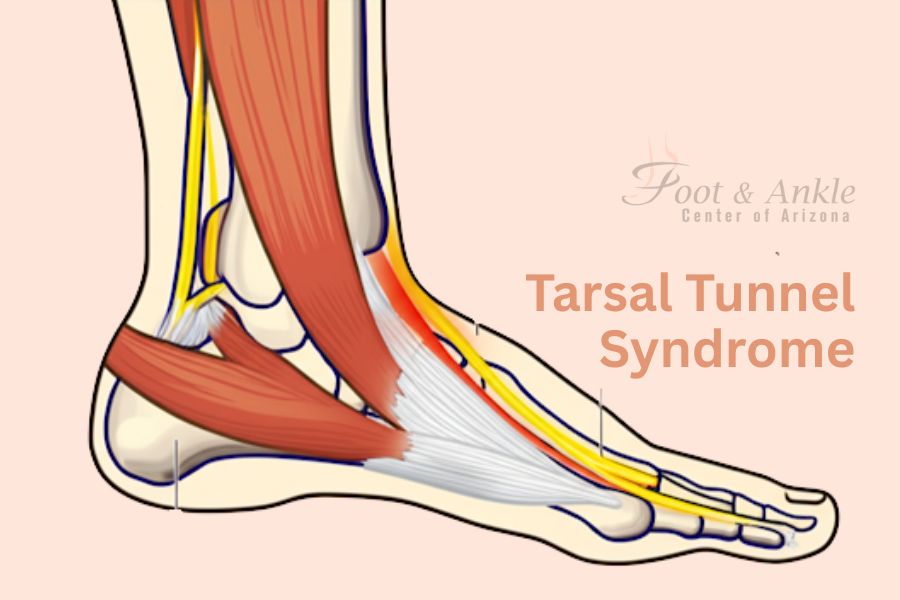The anatomical structure known as the tarsal tunnel is a slim passageway that resides on the ankle’s inner side, adjacent to the bones of the ankle – the tarsal bones. The tarsal tunnel’s exterior is safeguarded by a robust ligament called the flexor retinaculum, which serves to shield and maintain the integrity of its internal contents: arteries, veins, tendons, and nerves. Notably, this includes the posterior tibial nerve, which is pertinent to the condition known as tarsal tunnel syndrome.
What Is Tarsal Tunnel Syndrome?
Tarsal tunnel syndrome manifests as a restrictive pressure exerted upon the posterior tibial nerve. This pressure induces symptoms that can be experienced along the nerve’s trajectory from the ankle’s interior down into the foot.
The condition mirrors carpal tunnel syndrome, which is encountered in the wrist, with both scenarios involving nerve compression within a constrained area.
Causes Behind Tarsal Tunnel Syndrome
This syndrome can stem from various factors that increase pressure on the posterior tibial nerve:
- Those with flat feet can suffer from tarsal tunnel syndrome due to the heel tilting outwards linked to the collapse of arches, which can burden the nerve.
- Space-occupying lesions such as varicose veins, ganglion cysts, inflamed tendons, or bone spurs can encroach on the tunnel, thus compressing the nerve.
- Trauma like an ankle sprain might trigger inflammation and swelling that compresses the nerve locally.
- System-wide conditions like diabetes or arthritis can bring about swelling, and abetting nerve compression.
Symptoms of Tarsal Tunnel Syndrome
Individuals afflicted with this syndrome may undergo various symptoms:
- A tingling sensation, akin to burning, or feelings resembling electric shocks
- Loss of sensation or numbness
- Pain that can be acute and shooting in nature
These symptoms typically arise inside the ankle and/or underneath the foot. Occurrence patterns vary; some people may feel it intensively in a singular region, while others might experience it extending up to the heel, arch, toes, and even calf area.
The syndrome’s symptoms can emerge abruptly, often provoked or exacerbated by the foot’s overutilization, like during extended periods of standing, walking, exercise, or the commencement of new physical activities.
Prompt intervention is critical should any symptoms of tarsal tunnel syndrome surface to prevent progression and potentially permanent nerve damage. Moreover, as the condition’s symptoms can mimic other disorders, accurate assessment is imperative for a correct diagnosis to facilitate appropriate treatment.
Diagnosing Tarsal Tunnel Syndrome
A foot and ankle surgeon will meticulously examine the foot to diagnose and evaluate any sensory deficits. They will manipulate the foot and tap the nerve to ascertain if symptoms can be replicated. The surgeon will also palpate the area to identify the presence of any masses.
When initial interventions do not alleviate symptoms, or if a mass is suspected, advanced imaging could be ordered. Additionally, electromyography and nerve conduction velocity tests are considered should there be no improvement with conservative management.
Non-surgical Interventions
Tarsal tunnel syndrome treatment might involve a blend of therapies:
- Rest aids in averting further damage and supports healing.
- Ice application can manage the afflicted area, positioned intermittently with a towel barrier to prevent skin contact.
- Oral medications, specifically NSAIDs like ibuprofen, can significantly reduce pain and inflammation.
- Immobilization through casting can aid in healing by restricting foot movement.
- Physical therapy, comprising ultrasound and specific exercises, might be recommended to ameliorate symptoms.
- Injection therapy with local anesthetics can offer immediate pain mitigation and corticosteroids can assist in diminishing inflammation.
- Orthotic devices designed to maintain arch stability and limit motion can prevent excessive nerve compression.
- Shoes. proper footwear is also conducive to support.
- Bracing may be necessary for those with pronounced flatfoot or significant symptoms to diminish pressure on the foot.
When Surgery Becomes Necessary
For some, surgery could represent the optimal treatment route if conservative measures fail to deliver relief. A skilled foot and ankle surgeon will assess the need for surgery and decide on the most appropriate technique or combination thereof.
Choosing a Foot and Ankle Surgeon
Foot and ankle surgeons are the forefront authorities in concerns relating to foot and ankle care, including conditions like tarsal tunnel syndrome. These professionals also referred to as podiatrists or doctors of podiatric medicine, are endorsed by board certifications specific to podiatric surgery. They undergo comprehensive education and training, making them specialists in a wide breadth of surgical interventions, particularly in treating tarsal tunnel syndrome.




